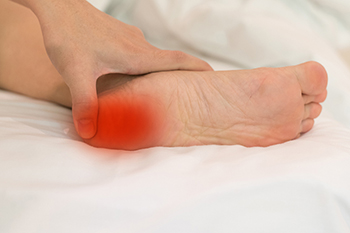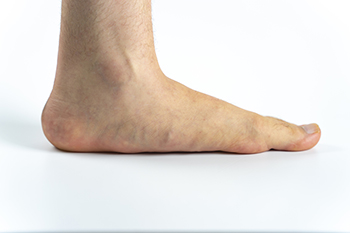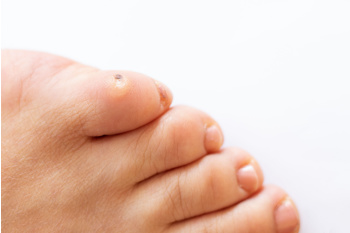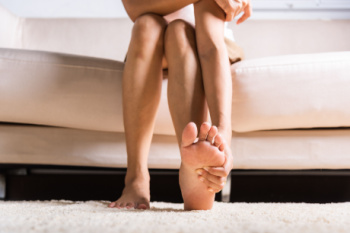Connect With Us
Blog
Items filtered by date: May 2025
Heel Pain in Growing Kids

Apophysitis of the calcaneus, also known as Sever’s disease, is a common cause of heel pain in children and teens, especially those who are active in sports. It happens when the growth plate in the heel becomes irritated from too much stress or pressure. This area is still developing in young people, so it is more sensitive to pulling from the Achilles tendon during running and jumping. The pain often feels like a dull ache or sharp discomfort in the back or bottom of the heel, and it may get worse with activity. The heel may feel sore to the touch or stiff in the morning. Rest and gentle stretching can help relieve symptoms. Supportive shoes or heel pads may also reduce pressure on the heel. If your child is limping or complaining of heel pain, it is suggested that you see a chiropodist for a proper diagnosis and appropriate treatment plan.
Sever’s disease typically affects young children and teenagers. If your child complains of foot pain, please consult with one of our chiropodists from West Toronto Foot & Ankle Clinic Inc. . Our chiropodist will assess your condition and provide you with quality foot and ankle treatment.
What Is Sever’s Disease?
Sever’s disease, also known as calcaneal apophysitis, is an inflammation of the growth plate in the heel bone. It is typically caused by overuse due to repetitive activities such as running, jumping, and playing certain sports. This condition most frequently affects children between the ages of 8 and 14.
Symptoms
Symptoms of Sever’s disease include:
- Pain in the back or bottom of the heel
- Pain when the sides of the heel are squeezed
- Limping or walking on tiptoes to avoid putting pressure on the heel
- Difficulty running, jumping, or participating in usual activities
- Fatigue
Diagnosis
Sever’s disease is diagnosed by taking a thorough medical history and performing a physical examination. Imaging studies, such as an X-ray, can help rule out other injuries like a fracture.
Treatment
Sever’s disease typically heals without any long-term complications. Treatment involves resting the affected foot by reducing typical activities, wearing orthotics to support the foot, immobilizing the affected foot, taking medications to reduce pain and inflammation, and stretching the foot.
If you have any questions, please feel free to contact our office located in . We offer the newest diagnostic and treatment technologies for all your foot care needs.
Symptoms and Relief for Flat Feet

Flat feet, also known as fallen arches, occur when the arches of the feet collapse, causing the entire sole to touch the ground. This condition may be present from birth or develop over time due to injury, aging, or strain. Common symptoms include foot pain, swelling, or aching in the arch or heel, especially after long periods of standing or walking. Flat feet can affect one foot or both, and the severity may differ between them. Although it is not always painful, it can lead to discomfort in the ankles, knees, or lower back. Relief options include wearing supportive footwear, orthotic inserts and stretching exercises. If you have flat feet, it is suggested that you are under the care of a chiropodist who can provide necessary treatment for existing pain and discomfort.
Flat feet are a common foot condition. If you are experiencing pain or discomfort due to flat feet, please consult with one of our chiropodists from West Toronto Foot & Ankle Clinic Inc. . Our chiropodist will assess your condition and provide you with quality foot and ankle treatment.
What Are Flat Feet?
Flat feet are feet that do not have a well-defined arch in the middle of the sole of the foot. Flat feet may be flexible or rigid. Flexible flat feet have an arch when there is no pressure put on the foot, such as when one is sitting, but the arch disappears upon standing. Rigid flat feet lack an arch regardless of whether one is standing or not.
Causes
Flat feet can be present from birth or acquired over time due to a weakening of the ligaments in the arch. Sometimes flat feet are caused by illnesses, injuries, or pregnancy.
Symptoms
Flat feet often cause no noticeable symptoms. However, some people may experience pain and discomfort due to their flat feet.
Symptoms associated with flat feet include:
- Pain in the arch, heel, ankle, or along the outside of the foot
- Overpronation of the foot
- Shin splints
- Aching or fatigue in the feet or legs
- Pain in the knees, hips, or lower back
Treatment
In cases where flat feet cause symptoms, there are various treatments available. Wearing orthotic inserts in your shoes to provide more arch support, performing stretches, and taking medications may improve your symptoms. If you are overweight, losing weight can help relieve pressure on the feet. In severe cases, surgery may be considered.
If you have any questions, please feel free to contact our office located in . We offer the newest diagnostic and treatment technologies for all your foot care needs.
Common Locations of Corns

Corns are small, thickened areas of skin that develop as a result of repeated pressure or friction. They often form to protect the skin from irritation, becoming dense and sometimes painful. Corns are commonly confused with calluses, but they tend to be smaller, deeper, and more painful to the touch. The main causes of corns include wearing tight or ill-fitting shoes, walking barefoot frequently, or having foot deformities such as hammertoes or bunions. Corns typically develop in areas where the bones of the feet rub against footwear. Common locations include the tops and sides of toes, between toes, and on the soles of the feet. Corns can be painful, and may cause difficulty in completing daily activities. If you have developed a corn, it is suggested that you consult a chiropodist who can offer relief and prevention tips.
Corns are small bumps or dry, hardened skin that can arise on the feet, usually in response to friction. Corns can be asymptomatic, or they can be uncomfortable or painful. If you have corns that are bothering you, please consult with one of our chiropodists from West Toronto Foot & Ankle Clinic Inc. . Our chiropodist can help you maintain the health of your lower limbs and your mobility.
There are three types of corns:
- Hard corns
- Often occur on the tops of toes
- Feature a hard core surrounded by dry, irritated skin
- Can be painful
- Soft corns
- Often occur in between the toes
- Soft due to constant exposure to sweat
- Can be painful
- Seed corns
- Tiny
- Often occur on the soles of the feet
- Usually asymptomatic
Corns can be prevented by wearing shoes that fit properly. They are typically benign and don’t require medical treatment. However, if your corns are causing you pain or discomfort, don’t hesitate to reach out to a chiropodist near you for treatment options. If you have any questions, please feel free to contact our office located in . We offer the newest diagnostic and treatment technologies for all your foot care needs.
Are You Suffering From Nerve Damage?
Common Causes of Arch Foot Pain

Arch foot pain can result from several conditions that affect the structure and function of the foot. One of the most frequent causes is plantar fasciitis, which involves inflammation of the thick band of tissue that supports the arch and connects the heel to the toes. Stress fractures in the bones of the foot, often caused by repetitive impact or overuse, can also lead to arch discomfort. Muscle strains from excessive physical activity or improper footwear may contribute to pain and fatigue in the arch area. Another possible cause is posterior tibial tendonitis, an inflammation of the tendon that helps support the arch and maintain stability during walking. If you have any type of foot pain, it is suggested that you contact a chiropodist who can accurately diagnose and treat the cause.
Foot pain is a common problem treated by chiropodists. If you have foot pain, please consult with one of our chiropodists from West Toronto Foot & Ankle Clinic Inc. . Our chiropodist can help you maintain the health of your lower limbs and your mobility.
When you are experiencing foot pain, it’s important to note the type of pain and its location, as this can help determine a diagnosis.
Pain in the top of the foot may be caused by:
- Stress fractures
- Sinus tarsi syndrome
- Extensor tendonitis
- Tibialis anterior tendonitis
- Gout
- Athlete’s foot
- Ganglion cysts
Pain in the bottom of the foot may be caused by:
- Plantar fasciitis
- Foot cramps
- Tarsal tunnel syndrome
- Plantar fibromatosis
- Posterior tibial tendonitis
- Stress fractures
- Flat feet
Pain on the side of the foot may be caused by:
- Ankle sprain
- Cuboid syndrome
- Peroneal tendonitis
- Stress fractures
- Bunions
- Corns or calluses
- Posterior tibial tendonitis
Heel pain may be caused by:
- Plantar fasciitis
- Achilles tendonitis
- Bone spurs
- Heel fractures
- Retrocalcaneal bursitis
- Sever’s disease
Pain in the toes may be caused by:
- Gout
- Hammertoe
- Turf toe
- Bunions
- Ingrown toenails
- Blisters
- Arthritis
These and many more conditions can be treated by a chiropodist. If you have any questions, please feel free to contact our office located in . We offer the newest diagnostic and treatment technologies for all your foot care needs.
Blog Archives
- November 2025
- October 2025
- September 2025
- August 2025
- July 2025
- June 2025
- May 2025
- April 2025
- March 2025
- February 2025
- January 2025
- December 2024
- November 2024
- October 2024
- September 2024
- August 2024
- July 2024
- June 2024
- May 2024
- April 2024
- March 2024
- February 2024
- January 2024
- December 2023
- November 2023
- October 2023
- September 2023
- August 2023
- July 2023
- June 2023
- May 2023
- April 2023
- March 2023
- February 2023
- January 2023
- December 2022
- November 2022
- October 2022
- September 2022
- August 2022
- July 2022
- June 2022
- May 2022
- April 2022
- March 2022
- February 2022
- January 2022
- December 2021
- November 2021
- October 2021
- September 2021
- August 2021
- July 2021
- June 2021
- May 2021
- April 2021
- February 2021
- January 2021

